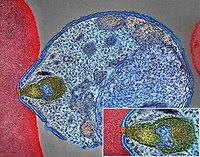
Photo from wikipedia
Context: In Mali, malaria transmission is seasonal, exposing children to high morbidity and mortality. A preventative strategy called Seasonal Malaria Chemoprevention (SMC) is being implemented, consisting of the distribution of… Click to show full abstract
Context: In Mali, malaria transmission is seasonal, exposing children to high morbidity and mortality. A preventative strategy called Seasonal Malaria Chemoprevention (SMC) is being implemented, consisting of the distribution of drugs at monthly intervals for up to 4 months to children between 3 and 59 months of age during the period of the year when malaria is most prevalent. This study aimed to analyze the evolution of the incidence of malaria in the general population of the health districts of Kati, Kadiolo, Sikasso, Yorosso, and Tominian in the context of SMC implementation. Methods: This is a transversal study analyzing the routine malaria data and meteorological data of Nasa Giovanni from 2016 to 2018. General Additive Model (GAM) analysis was performed to investigate the relationship between malaria incidence and meteorological factors. Results: From 2016 to 2018, the evolution of the overall incidence in all the study districts was positively associated with the relative humidity, rainfall, and minimum temperature components. The average monthly incidence and the relative humidity varied according to the health district, and the average temperature and rainfall were similar. A decrease in incidence was observed in children under five years old in 2017 and 2018 compared to 2016. Conclusion: A decrease in the incidence of malaria was observed after the SMC rounds. SMC should be applied at optimal periods.
Journal Title: International Journal of Environmental Research and Public Health
Year Published: 2021
Link to full text (if available)
Share on Social Media: Sign Up to like & get
recommendations!